RetroLisa
----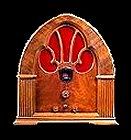 |
1940s Town & Country | |
|
___________________________________________________________________________________________________________
|
|
|
RetroLisa
x | ____________________________________________________________ | __ | ____________________________________ | _______ | The City
The city was a world of department stores, crowded sidewalks, fancy hotels and fire escapes. It was the hustle and bustle of subways and streetcars, the glamour of theaters and nightclubs.
In most cities, a building of 20 stories qualified as a skyscraper. New York City had the world's tallest....the Chrysler Building with 77 stories, and the Empire State Building with 102 stories.
Empire State Building
Chrysler Building
Downtown Greensboro Memories
Our way of life was becoming increasingly urban, and by the 1940s we had passed the halfway point. 55 percent of us lived in towns and cities of all sizes in 1940. In urban areas, the distribution of homes was split evenly between the city and the suburbs. This began to change in the late 1940s when the mass exodus to the suburbs began in earnest.

Nighthawks by Edward Hopper, 1942
--sometimes the city can be the loneliest place of all

Times Square
New York City was the center of everything that was modern and vibrant in the 1940s. It was the Wonder City, the Radio City, the true melting pot. It was the Statue Of Liberty, Times Square and the Empire State Building. It was Radio City Music Hall and Broadway. It was nightclubs and baseball games, hot dogs and egg creams.
New York City Images
Times Square
New York Egg Creams
| |



|
_________________________________________________
|
|
|
RetroLisa
| __________________________________________________________ | __ | ______________________________________ | _______ | Small Towns
The pace of small town life was relaxed. Stores, businesses and parking meters could be found on Main Street. The neighborhood grocery was just a few blocks away. Typical communities had parks surrounded by town squares, churches, barbershops, dry-cleaners and drugstores. Friendly telephone operators connected your calls, and everyone knew everyone else.

Most towns had some sort of streetcar service, which resulted in streets criss-crossed by streetcar tracks
| |


|
_________________________________________________
|
|
|
RetroLisa
| ________________________________________________ | ___ | ______________________________________________ | ________ | The Suburbs
Suburbs are divided into categories based on the method of transportation that connects them to the city. They can be as close as the city limits or an hour away by train.
older suburbs
In the late 1800s, railroad and streetcar suburbs first appeared along the rail and trolley lines that radiated out from the city center. They reached their peak in the 1920s.
Early automobile suburbs were located in areas without rail access. They were built with the automobile in mind and were settled by affluent car owners who didn't depend on rail travel. They were popular between 1905 and 1945 and featured paved streets, landscaping and sunny open areas.

Levittown
On Long Island, Levittown was the first major suburb of the postwar era. This subdivision was built by the firm of Levitt & Sons, and the first homes were completed in 1947. In 1949, a two-bedroom house sold for $7,900.
The subdivision featured ball fields, swimming pools, streets uncluttered by utility poles, and no fences. The homes were built quickly and efficiently, sometimes at the rate of 30 per day. Unfortunately, the subdivision had covenants preventing blacks and Jews from buying homes there, which was a standard practice at the time. Levittown was immensely popular.
| |

after the war:
the freeway suburb
Things began to change dramatically after the war. Servicemen returned from overseas and got married in record numbers. This created a housing shortage, especially in the city. Eager for a fresh start, Americans turned their attention to the open countryside.
On the outskirts of town, developers replaced farm fields with cul-de-sacs, sidewalks and rows of identical tract houses. These housing developments were connected to the city by freeways and expressways. This gave us the newest type of suburb: the freeway suburb.
It didn't matter if these subdivisions were miles away from the city center. They would become self-contained communities with shops and schools of their own. The booming postwar economy made it possible for most people to own a car, so transportation wasn't a problem.
Between 1945 and 1951, the population of the suburbs doubled. Much of this growth took place in the new postwar freeway suburbs.
Levittown: An Ideal American Suburb
Levittown's Legacy Of Bias
|
__________________________________________
|
|
|
RetroLisa
| _____________________________________________________________ | __ | ___________________________________ | _______ | Quick Service Dining

soda fountains
lunch counters
Most drugstores and department stores had a place where hungry shoppers could stop for ice cream or a light lunch. Workers on their lunch breaks also favored simple, inexpensive drugstore lunch counters.
soda shops
sandwich shops
Sandwich shops and hamburger joints served ice cold soft drinks, thick milkshakes and hot, juicy burgers. Teens enjoyed gathering at the local soda shop, where they could chat with friends, have a snack and listen to the jukebox.
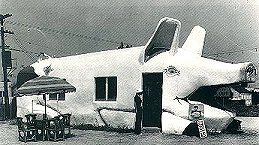
drive-ins
snack stands
The drive-in restaurant was born in the 1920s, when car travel became common and the automobile became a way of life. The fast food industry continued to grow in the 1940s as more Americans took to the roads after the war. Thanks to car hops and curb service, you didn't even have to get out of your car!
In 1948, the McDonald brothers converted their San Bernardino barbecue restaurant into the first McDonalds drive-in. The new eatery replaced carhops and elaborate menu items with 15 cent hamburgers, 10 cent french fries, triple thick milkshakes and a revolutionary new Speedee Service System.
The first Dairy Queen opened in Joliet, Illinois in 1940. It was one of the first establishments to sell a new type of ice cream known as soft serve.
In the city, hot dog stands and ice cream vendors were popular.
The highways were dotted with snack stands that resembled the food they were selling. Giant hot dogs, chickens, donuts, pigs, milk bottles and root beer barrels served as both buildings and advertisements.
Novelty Architecture
Roadside Eateries With "Big Food"
Vintage Roadside Eateries
Jilly's Drive-In Restaurant Page
| |

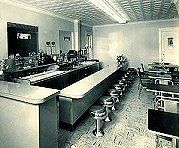
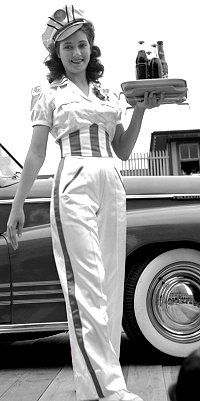

Click here for more
restaurants from the 1940s!
|
_________________________________________________
|
|
|
RetroLisa
| ____________________________________________________________ | __ | ____________________________________ | _______ | Casual & Fine Dining
for travelers
Truck stops and roadside cafes increased in popularity after the war. People were taking longer car trips and hauling products by truck, and the focus was shifting from train travel to the automobile.
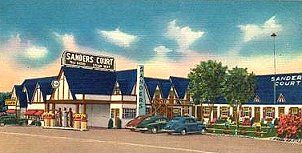
Down in Corbin, Kentucky, the Sanders Court & Cafe was famous for its fried chicken.
The Harvey House chain, which catered primarily to train passengers, began to lose business as car travel became more common. Business picked up briefly during the war years when gas was rationed and thousands of soldiers shipped out on troop trains. After the war, the company focused on opening restaurants in other locations, such as bus terminals and airports.
casual dining
At the self-service cafeteria, you could enjoy a wide range of dishes at reasonable prices. In the city, the automat took self-service to a whole new level. Here, everything was dispensed from machines. Customers put their nickels in, made their selections, and opened the glass doors to get their food. The coffee was especially good.
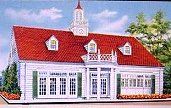
The first Howard Johnson's ice cream parlor opened in 1925. By the 1940s, the chain was serving complete meals at clean, colonial-style restaurants. The new Pennsylvania Turnpike featured a Howard Johnson's restaurant at every service plaza, and it was these locations that helped keep the chain in business during the lean war years.
Italian and Chinese restaurants put an American spin on their native dishes, and in the process they created new favorites like chop suey, pizza and spaghetti with meatballs. Chicago's Pizzeria Riccardo opened its doors in 1943, serving up the latest gastronomic marvel....deep dish pizza.
In Los Angeles, the Coffee Dan's chain pioneered a modernistic form of architecture that would later be known as Googie. The Pig 'n Whistle chain was also popular with families in the Los Angeles and San Francisco areas.
Chicago's Deep Dish History
Restaurant Matchbooks

diners
Found predominantly in the eastern United States, diners were factory-built eateries that evolved from horse-drawn lunch wagons.
New Jersey Diners
Diners Of New York
Ohio Diners | |

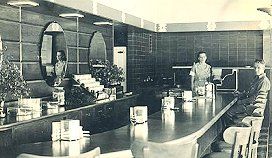

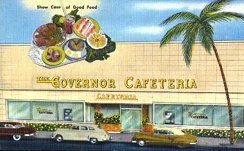

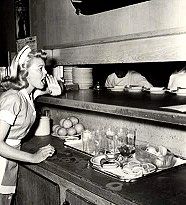
"Adam and Eve on a raft and a
cup of Joe for table four!"
Diner Lingo

Click here for more
restaurants from the 1940s!
|
| ______________________________ | _________________________ | __ | _______________________________________ | _______ |
fine dining
trendy spots
New York City
- Sardi's
- Black Angus
- Jack Dempsey's Restaurant
- Hotel Lincoln Blue Room
- "Toots" Shor
- Roosevelt Grill
- 21 Club
- Rumpelmayer's
- Le Pavillon
- St. Regis Hotel Oak Room
- The Maisonette
- Plaza Hotel Oak Room
- Plaza Hotel Palm Court
- Pierre Grill
- Cafe Pierre
- The Colony
- Astor Roof
- Keen's English Chop House
San Francisco
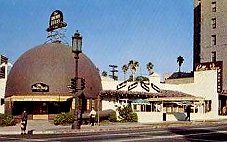
In Los Angeles, the four Brown Derby locations were very popular with the after-hours crowd. The Hollywood location was known for its celebrity clientele. The menu to the right features celebrity caricatures on the cover.
|
Chicago
- Henrici's
- The Berghoff
- Camellia House
- Marine Dining Room
- Blackhawk Restaurant
- Mayfair Room
- Barney's Market Club
- Pump Room
- Colosimo's
Los Angeles

| |

many cities
other cities
- Minneapolis:
----• Charlie's Cafe Exceptionale
- Oakland:
----• Trader Vic's
- Washington D.C.:
----• Occidental Restaurant
- New Orleans:
----• Arnaud's
- Milwaukee:
----• Mader's Restaurant
Tips On Tables: Nightclubs & Restaurants
New York City Restaurants In 1940
Adventures In Good Eating

From the mid 1930s to the 1950s, we were guided to the best restaurants in the country by Adventures In Good Eating, a traveler's guidebook written by Duncan Hines (the man, not the brownies!)
The Trader Vic's and Don The Beachcomber restaurant chains popularized Asian cuisine, Polynesian decor and the Mai Tai.
After the 1939-1940 New York World's Fair was over, the manager of the French Pavillion remained behind and opened the city's premier French restaurant....Le Pavillon.
|
_________________________________________________
|
|
|
RetroLisa
| ___________________________________________________________________ | __ | _____________________________ | _______ | Shopping
This section hasn't been moved yet.
Click the link below to visit the original page.
1940s Shopping
| |
|
_________________________________________________
|
|
|
